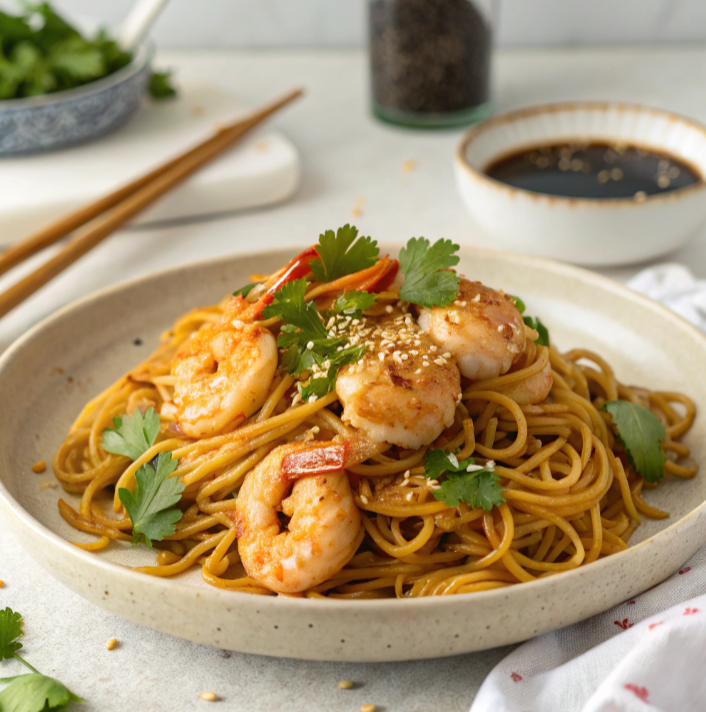Shrimp noodles are a versatile and beloved dish, combining the rich flavors of seafood with the hearty texture of noodles. This culinary delight has gained immense popularity due to its adaptability to various cuisines and dietary preferences. With a perfect balance of taste and nutrition, shrimp noodles cater to food enthusiasts who value quality and flavor. Throughout this article, we’ll explore the intricacies of this dish, from its origins to its global variations, offering insights that make it a perfect choice for both beginners and seasoned cooks.
Overview of Shrimp Noodles
This noodles recipe consist of succulent shrimp paired with noodles crafted from diverse ingredients like rice, wheat, or starch. This dish offers a harmonious blend of textures, making it a favorite among food lovers. Whether stir-fried, soupy, or steamed, shrimp noodles present endless possibilities for preparation. Their flexibility in pairing with various sauces and spices further adds to their appeal, ensuring there’s a version to suit every palate.
Historical Context: Origins of Shrimp Noodles
The origins of this dish can be traced back to ancient coastal regions, where seafood was a staple in everyday meals. Communities in East and Southeast Asia pioneered the combination of shrimp and noodles, leveraging their abundant access to fresh ingredients. Over centuries, trade routes spread this dish globally, infusing it with unique cultural flavors and techniques. Today, shrimp noodles symbolize a culinary bridge between tradition and innovation, with each region adding its own spin to the recipe while staying true to its essence.
Popularity Across Different Cultures
Noodles with shrimp are celebrated worldwide, with each culture adding its distinct twist. In Asian cuisine, they are often stir-fried or served in broths, showcasing umami flavors. Mediterranean recipes highlight this recipe with olive oil and fresh herbs, while Western adaptations often feature creamy sauces. This cross-cultural appeal underscores the dish’s universal charm, making it a staple on dinner tables and restaurant menus alike. Moreover, its versatility allows it to adapt to dietary restrictions, such as gluten-free or low-carb preferences.
Types of Noodles with Shrimp
Rice Noodles with Shrimp
Rice noodles provide a light and gluten-free base, perfectly complementing the delicate flavor of shrimp. These noodles absorb sauces effortlessly, enhancing the overall taste. Popular recipes include Pad Thai and Vietnamese pho, both of which highlight shrimp as the star ingredient. Rice noodles are also ideal for cold salads, where the shrimp’s sweetness contrasts beautifully with tangy dressings. Additionally, rice noodles offer a healthier alternative to fried varieties, making them a preferred choice for health-conscious diners.
Egg Noodles with Shrimp
Egg noodles bring a rich and chewy texture to shrimp dishes. Often used in Chinese and Italian cuisines, these noodles pair well with savory sauces and stir-fried preparations. Their versatility makes them a go-to choice for various shrimp noodle recipes. In soups, egg noodles add depth, while in stir-fries, they provide a satisfying bite. When paired with creamy sauces or soy-based dressings, egg noodles deliver a balance of indulgence and flavor.
Glass Noodles with Shrimp
Glass noodles, made from starch, are known for their translucent appearance and springy texture. These noodles are commonly featured in Asian salads and soups, offering a visually appealing and flavorful option for shrimp lovers. They pair particularly well with light broths and zesty dressings, making them a popular choice for health-conscious diners. Moreover, their ability to soak up flavors without becoming soggy makes them a preferred option for meal prep and leftovers.
Health Benefits of Noodles with shrimp
Nutritional Value of Shrimp
Shrimp is an excellent source of lean protein, vitamins, and minerals, including selenium and vitamin B12. These nutrients support overall health while promoting energy and immunity. Additionally, shrimp is low in fat and calories, making it a perfect ingredient for those managing their weight without compromising on flavor. The presence of omega-3 fatty acids in shrimp contributes to heart health and cognitive function, further enhancing its nutritional profile.
Benefits of Noodle Ingredients
Noodles made from whole grains or gluten-free alternatives add fiber and essential nutrients to meals. Combined with shrimp, they create a balanced and satisfying dish. Incorporating vegetables further boosts the nutritional value, providing a meal that is both hearty and wholesome. Whole-grain noodles, in particular, are rich in antioxidants and can help regulate blood sugar levels, making them a great choice for individuals with diabetes.
Low-Fat and High-Protein Options
Shrimp noodles are an ideal choice for those seeking a low-fat yet protein-rich meal. Incorporating vegetables and lean sauces further enhances their health benefits. This combination is particularly beneficial for maintaining muscle health, improving digestion, and supporting a healthy metabolism. Substituting heavy creams with lighter alternatives like coconut milk or broth can reduce calorie content while preserving flavor.
How to Cook Shrimp Noodles at Home
Simple Recipes for Beginners
For a quick and easy meal, sauté shrimp with garlic, toss in cooked noodles, and finish with soy sauce and sesame oil. This basic recipe is both delicious and beginner-friendly. Add a splash of lime juice and a sprinkle of chili flakes for an extra kick. Beginners can also experiment with pre-made sauces to save time while achieving a flavorful result. A drizzle of honey or a pinch of sugar can balance out salty or tangy flavors for a harmonious dish.
Advanced Shrimp Noodle Dishes
Experienced cooks can experiment with complex recipes like seafood laksa or shrimp noodle stir-fry with tamarind sauce. These dishes require layering flavors for a restaurant-quality experience. For an elevated dish, consider making your own broth or sauce from scratch using fresh herbs and spices. Adding premium ingredients such as scallops or lobster can transform a simple shrimp noodle dish into a luxurious dining experience.
Common Mistakes to Avoid
Avoid overcooking shrimp, as it can result in a rubbery texture. Additionally, ensure the noodles are not overcooked to maintain their perfect bite. Always taste and adjust seasonings as you cook, ensuring each element complements the others without overpowering them. Using too much sauce can also mask the flavors of fresh ingredients, so it’s essential to strike a balance.
Detailed Ingredients
Base Ingredients
- Shrimp: 300g of fresh or frozen shrimp, peeled and deveined, preferably medium to large-sized.
- Noodles: 200g of rice noodles, egg noodles, or glass noodles, depending on preference.
Vegetables and Aromatics
- Vegetables: 150g of mixed vegetables such as sliced carrots, julienned bell peppers, snap peas, bean sprouts, and baby bok choy.
- Garlic: 2 cloves of minced garlic for a robust flavor.
- Ginger: 1 teaspoon of freshly grated ginger to add warmth and depth.
- Green Onions: 2 stalks, finely chopped, for garnish and mild onion flavor.
Sauces and Seasonings
- Soy Sauce: 2 tablespoons for a savory base.
- Oyster Sauce: 1 tablespoon to enhance umami.
- Fish Sauce: 1 teaspoon for a touch of saltiness and depth.
- Sesame Oil: 1 tablespoon for a nutty aroma and flavor.
- Chili Flakes: To taste, for a spicy kick.
- Salt and Pepper: To taste, for seasoning.
- Lime Juice: 1 tablespoon of fresh lime juice to brighten flavors.
Garnishes and Optional Additions
- Cilantro: Freshly chopped, for a refreshing herbaceous note.
- Toasted Sesame Seeds: 1 teaspoon for added crunch and flavor.
- Lime Wedges: For serving, allowing guests to adjust acidity.
- Optional Add-ins:
- Scrambled eggs for added protein.
- Sliced mushrooms for umami and texture.
- Tofu cubes for a vegetarian protein boost.
- Crushed peanuts for crunch.
Regional Variations of Shrimp Noodles
Shrimp Noodles in Asian Cuisine
Asian recipes often incorporate bold spices and aromatics. Dishes like Singaporean chili shrimp noodles and Thai curry noodles highlight the use of regional ingredients. These dishes emphasize balance, combining sweet, salty, sour, and spicy flavors in every bite. Chinese-style shrimp noodles often feature dark soy sauce and bok choy, creating a savory and hearty meal.
Shrimp Noodles in Mediterranean Dishes
Mediterranean variations emphasize simplicity, using olive oil, lemon, and herbs to enhance the natural flavors of shrimp. These recipes often include tomatoes, capers, and garlic, adding a burst of freshness to the dish. The addition of artichokes or olives can further elevate the Mediterranean flair, making it a delightful option for summer meals.
Fusion Recipes
Fusion dishes combine elements from different cuisines, such as shrimp Alfredo noodles with a hint of soy sauce or miso-infused pasta dishes. These recipes showcase the creativity of modern chefs, blending traditional flavors with contemporary techniques. Fusion shrimp noodles allow for endless experimentation, from spicy Cajun-inspired versions to creamy Japanese-style preparations.
Storing and Reheating Shrimp Noodles
Best Practices for Leftovers
Store shrimp noodles in an airtight container to preserve freshness. Ensure the noodles and shrimp are cooled to room temperature before refrigerating. Consuming within 2-3 days is recommended for the best flavor and texture. Label containers with the storage date to avoid confusion. Proper storage not only maintains quality but also reduces the risk of bacterial growth.
Reheating Methods to Retain Freshness
When reheating shrimp noodles, use a skillet over medium heat with a splash of water or broth to maintain moisture. Alternatively, microwave on a low setting in short intervals, stirring between each to avoid uneven heating. Adding a small amount of fresh sauce or seasoning can revive the flavors. Avoid reheating multiple times to retain the original taste and texture.
Avoiding Overcooking During Reheating
Reheating shrimp noodles requires careful attention to avoid overcooking the shrimp, which can become rubbery. Heat until just warmed through, ensuring the noodles remain tender. Using a lid during reheating can help trap steam and evenly heat the dish. For best results, consume reheated shrimp noodles promptly.
Frequently Asked Questions
What do people eat noodles with?
Noodles pair wonderfully with a variety of accompaniments, offering endless possibilities. Common choices include stir-fried vegetables, crispy spring rolls, and flavorful proteins like shrimp, chicken, or tofu. Additionally, noodles can be served alongside soups, broths, or even spicy chili oil for an extra kick. For a balanced meal, pairing noodles with fresh salads or steamed greens is highly recommended.
What tastes good with shrimp?
Shrimp’s natural sweetness and tender texture make it incredibly versatile. It pairs excellently with citrus flavors like lemon and lime, as well as with garlic, butter, and herbs such as parsley or cilantro. Spicy elements like chili flakes or paprika enhance its flavor profile, while creamy sauces or coconut milk add depth. For an Asian twist, soy sauce, sesame oil, and ginger are ideal complements.
What are shrimp noodles?
Shrimp noodles are a delightful dish that combines plump, juicy shrimp with a variety of noodles such as rice, egg, or glass noodles. These dishes often incorporate vibrant sauces, vegetables, and spices, creating a harmonious blend of flavors and textures. Shrimp noodles are prepared in many styles, including stir-fried, soupy, or cold salad variations, making them a global favorite.
How to make shrimp ramen noodles taste better?
To elevate shrimp ramen noodles, start by enhancing the broth with fresh aromatics like garlic, ginger, or green onions. Adding a splash of soy sauce, sesame oil, or chili paste can create a richer flavor. For a more robust dish, include fresh vegetables such as spinach, mushrooms, or carrots. Top with a soft-boiled egg, a squeeze of lime, and freshly chopped herbs like cilantro or basil for a gourmet touch.
Conclusion
Shrimp noodles offer a delightful combination of flavors, textures, and cultural richness. Whether enjoyed as a quick homemade meal or a gourmet restaurant dish, they embody the perfect balance of taste and nutrition. With the detailed guidance provided here, you can master every aspect of shrimp noodles, from selecting ingredients to perfecting cooking techniques. Dive into this culinary journey and savor the endless possibilities that shrimp noodles bring to your table. Their adaptability ensures they remain a timeless favorite, offering satisfaction and nourishment in every bite.

